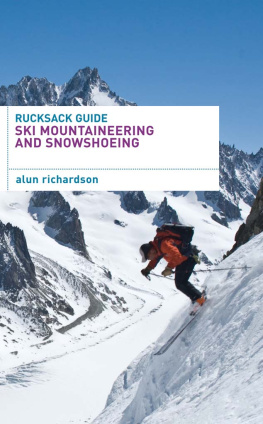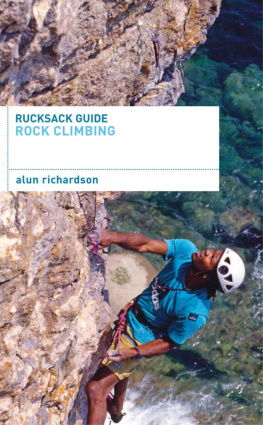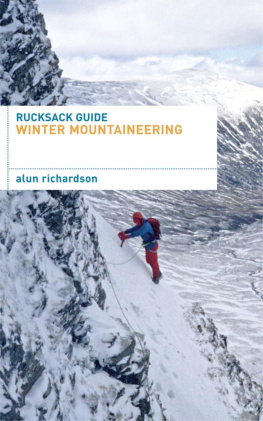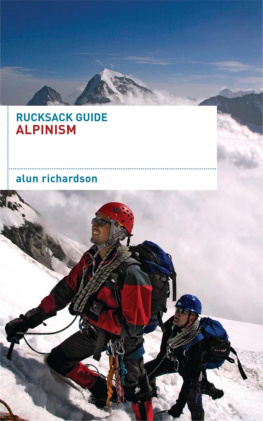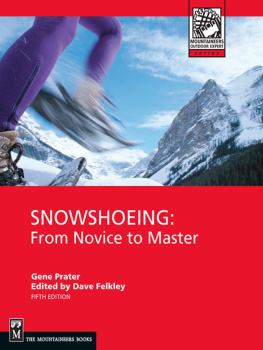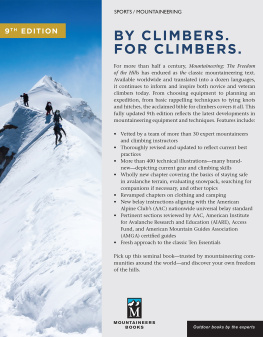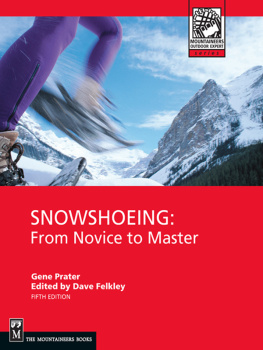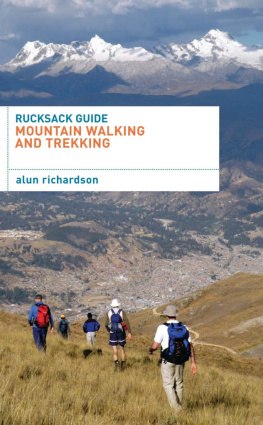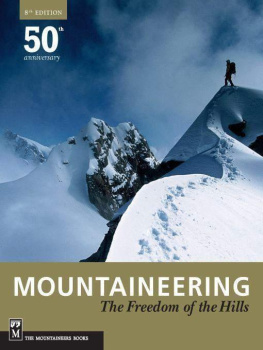Ski Mountaineering and Snowshoeing is the fifth book in the Rucksack Guide series and covers the skills required to become a competent ski mountaineer. This handy book can be kept in your rucksack and will help you to gain the experience to ski mountaineer safely anywhere in the world. It does not cover the technical aspects of navigation, alpinism, snow and ice climbing (see Rucksack Guides to Mountain Walking and Trekking, Alpinism and Winter Mountaineering).
The Rucksack Guide series tells you what to do in a situation, but it does not always explain why. If you want more information behind the decisions in these books, go to Mountaineering: The Essential Skills for Mountaineers and Climbers by Alun Richardson (A&C Black, 2008).
For more information about the author, his photographs and the courses he runs go to:
www.alunrichardson.co.uk.

Andy Perkins (IFMGA), Chamonix
Skiing is the pleasurable part of alpinism way more pleasurable and fun than alpine climbing.
Michael Kennedy, former Editor of Climbing magazine
For the ski mountaineer, leaving a tent or a hut as the sun creeps up over the mountains, with the prospect of a four-hour ascent and a one-hour ski back down untracked snow is the stuff of dreams. It is the most wonderful way to get away from the crowded pistes and experience the mountains in their winter clothes.
Ski mountaineering is a complex pastime combining the skills of Alpinism and skiing. You must have the ability to ski off-piste; navigate; choose a safe line; be aware of the mountain environment in winter; assess and test snow conditions for avalanches; use an avalanche transceiver, probe and shovel; travel safely on glaciers; and use the rope, ice axe and crampons for descending and ascending steep snow slopes.
Ask a Mountain Guide whom they would rather take ski mountaineering out of a skier or a mountaineer, and they will always say the skier. Ski mountaineering is not for novice skiers, but you dont have to be an expert either. If you can combine mountaineering skills with the ability to link controlled, parallel carved turns, on-piste while wearing a small rucksack, you can probably attempt some very easy tours in good snow conditions. However, do not overestimate your skiing ability with more serious tours.
For most skiers contemplating ski mountaineering the problem is that the snow off-piste can vary from deep powder to crust. Mountaineering experience will not compensate for lack of skiing ability but, as long as you can traverse, side-slip, snowplough turn and perform a downhill kick-turn, you will be able to find your way down most slopes, albeit more slowly and, therefore, having less fun. The opposite is also true; good skiers should also be aware that losing a ski or fracturing a limb in a remote area is serious.

Skier Owen Cox
Ski mountaineering differs from alpine skiing, in that the bindings free the heel for walking along and up snow slopes. Equipment specifically designed for ski mountaineering is always a compromise between the two disciplines of skiing and mountaineering. For instance, ski mountaineering bindings do not have all the release possibilities of the best downhill bindings; boots are lighter but, more flexible than piste boots; and ice axes are light, but do not perform very well on ice. However, the gap in safety and performance is becoming smaller.
There are two ski disciplines, each with its own band of faithful followers.
Nordic ski bindings leave your heels free all of the time, so you dont have to change between uphill and downhill modes. The boots flex at the toe for more natural walking and the bindings have a spring-loaded cable that fits around the heel of the boot and a front toe binding.
Nordic skiing is sometimes referred to as telemark skiing, but the telemark is actually a turn, not a ski. There is no doubt that Nordic skis have an advantage on gently rolling terrain, but, unless you are an advanced Nordic skier who has mastered the telemark turn with a rucksack on, do not consider using Nordic skis for tours that have substantial steep descents, especially if you want to have fun.
A further downside of using Nordic skiing for ski mountaineering is that the boots are difficult to use with crampons and useless for kicking steps into snow.

There is a saying that goes free the heel and free the mind, but mine is fix the heel and fix the problem.
For ski tours with steep downhill sections, there is no doubt that AT gear is a superior choice and will allow an average skier to cope with a wider variety of snow conditions.
Every ski has its pros and cons and your choice will depend on the type of ski touring you do, how heavy you are and how aggressively you ski (stiffer skis need to be bent). The first thing to decide is whether travelling between huts is a priority, or making better and safer turns is more important. If it is the former, buy a lighter purpose-built touring ski that may have holes in the tips for clipping in a krab. If you are a skier at heart your task is more difficult. Modern All mountain skis, such as the Salomon X-Wing Fury, are designed to be skied shorter for a given weight and height. Choose a ski between your own height to 10cm shorter, but make sure it is compatible with the combined weight of you and your rucksack.
WHERE DID IT ALL START? |

|
Ski is an old Norse word meaning stick of wood. The earliest reference to skis are on 5000-year-old drawings in Norway, but the Englishman Cecil Slingsby was one of the first Europeans to use skis for mountaineering when he crossed the 1550m Keiser Pass, Norway, in 1880. In 1888 the Norwegian Fridtjof Nansen made the first crossing of Greenland. However, the father of the sport is generally regarded as the German Wilhelm von Arlt, who made the first ski ascent of the Rauris Sonnblick (3103m) in 1894. The first ski tour in the European Alps occurred in 1894 near Davos, when Sir Arthur Conan Doyle and the Branger brothers travelled from Frauenkirch to Arosa. |
WAXING SKIS |

|
It is probably not a good idea to hot wax skis before ski mountaineering, as the wax will reduce the effectiveness of the glue on the skins. |
Tip width
The wider it is compared to the waist width, the greater the pull of the ski in the turn.
Waist width
The narrower it is, the quicker the edge change and the better the edge grip on hard snow.
The wider it is, the more speed and tracking stability you get on off-piste snow, but the poorer the edge grip on hard snow.

